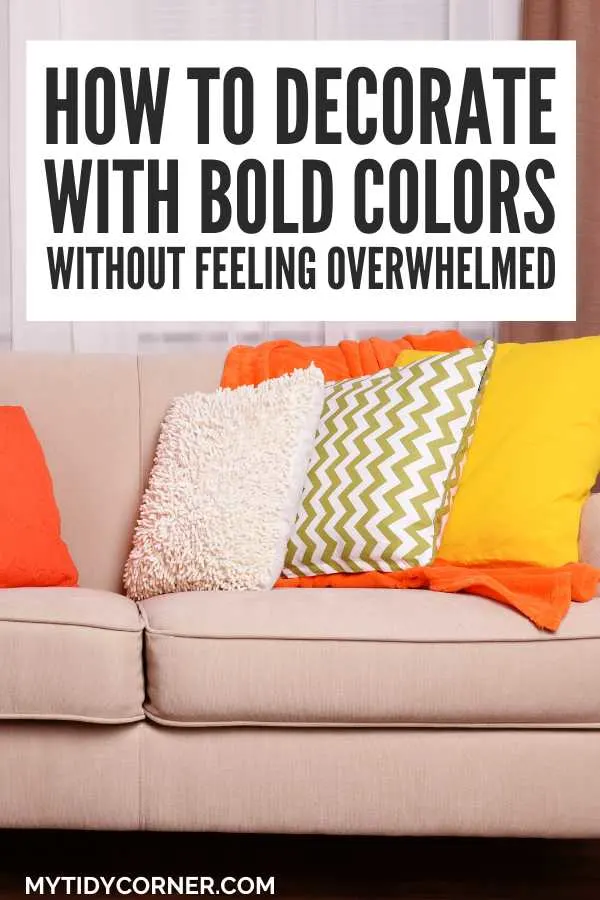Are you looking to experiment with vibrant colors? Learn how to decorate with bold colors without feeling overwhelmed. Find out how to incorporate bright shades without overpowering your space.
I am one of those people who find color refreshing and energizing. Neutral tones are all very well for hotel rooms, but at home, I want a vibrant environment.
From experience, I’ve learned that I’m in the minority, and most people are nervous about using color in their homes. Let’s look at how to decorate with bold colors without feeling overwhelmed.
Avoid overwhelm when decorating with bold colors by choosing favorite colors that match the space’s ambiance. Follow the 60-30-10 rule, using toning colors and avoiding patterns, high contrast, neons, and primary colors. Start in smaller spaces and add bursts of color, rather than drenching a room.

The excellent news for anxious and unsure color novices is that using bold colors in your home transforms the mood immediately, creating a positive and uplifting impact.
Are you nervous about combining colors or ending up with a kindergarten playroom? Let me encourage you to take the color plunge — without drowning.
#1. Choose Colors You Love

We all have favorite colors (for most people, it’s blue). Embark on your colorful decorating journey by trusting your gut. Which colors do you gravitate towards in the garden, your wardrobe, and shops?
If you constantly catch yourself gazing at a bright green sofa, chances are you’d be happy to live with it. Surround yourself with your favorite colors and experiment with them in your home.
#2. Pick Your Vibe

If you can’t trust your own taste, turn to color theory. Most colors create a mood or atmosphere, so pick colors that vibe with you and your home.
For example, green is associated with serenity and the natural world, which works well for a quiet, laid-back family.
On the other hand, red is an intense color known to increase your metabolism, so it is perfect for busy, energetic people.
#3. Consider Space and Function

The ambiance a color creates will match certain rooms better than others.
For example, do you have a large, airy family room where everyone love to relax? Fill it with blues and greens that make a striking impact, but are still tranquil and inviting.
For an entertainment area or family kitchen, you could choose yellow, a cheerful, welcoming color. This color also works well in south-facing and light-starved rooms, brightening them up.
Conversely, a bedroom is an intimate, tranquil space for resting. So a charming, serene pink or lavender is ideal.
#4. Keep It Balanced

To avoid colors becoming garish and overwhelming, follow the designers’ 60-30-10 rule.
This classic guideline creates a cohesive palette. The rule involves choosing three colors and using them in balanced proportions:
- Use the anchor color for 60% of the palette, such as painting the walls.
- The secondary color is used 30% of the time, for instance, in furniture or drapes.
- The third color is the accent shade, with only 10% of the scheme in this color, such as accessories or pillows.
#5. Try Tones

Another way to keep your palette balanced and avoid being overwhelmed by color is to limit contrast and stick to toning shades.
The nearer colors are on the color wheel, the more harmonious and tranquil the scheme.
Colors next to each other are tones of a single color, creating a relaxed monochromatic scheme. Play with shades of a single color to dip your toe into brightness.
Colors near each other on the wheel are equally serene and appropriate for a home office or study.

Choosing colors from the opposite side of the color wheel increases the contrast, creating a more intense and dynamic impact.
Decide which feel you want to create. For instance, a children’s playroom can have an energetic, fun vibe.
#6. Stay Sophisticated

There is a common misconception that neutral shades are chicer and more sophisticated than vivid colors. You’ll find that designers disagree completely.
If you’re anxious about decorating with color because you think it isn’t classy, think again. If you plan your color palette and apply it in high-quality, solid colors, you can create as elegant a space as any of the beige brigade.
Stick to solids to keep a color-forward interior sophisticated rather than introducing pattern. This is because patterns are trickier for our brains to process and comes across as overwhelming and overstimulating.
Also, avoid primary colors, neons, and luminous shades — earthy, muted tones are still bold but not gaudy.
#7. Start Small

Painting your living room violet may seem too big a step for color novices. Instead, choose a smaller space to step out of your comfort zone.
Try decorating a powder room, pantry, or laundry room where it’ll have a significant impact colorwise, but won’t overwhelm the rest of the house.
Small rooms lend themselves to bold colors, creating tiny jewel-box spaces. Using color in these interiors can be unexpected and fun.
Rather than painting a whole wall, paint the back of the door or the trim a stunning color. Or use temporary peel-and-stick wallpaper.
#8. Use Bursts of Color

You don’t have to commit to colorwashing an entire room to add color. And even though I joke about neutrals, there’s no need to abandon your love of pale gray or cream.
Anchor your interior with neutral walls and introduce bold colors in small doses to avoid overstimulation. If there’s a bold accent, neutral walls give your eyes a breather.
Introducing small bursts of brightness is a relatively inexpensive way to add vibrancy to your home, especially if you’re trepidatious about the color plunge.
For example, upcycle a piece of furniture by giving it a lick of paint. One stunning statement piece will punctuate a room with a punch of color.

Bring in a burst of color with accessories, soft furnishings, bedding, or striking artwork. Add an eye-catching rug and pick out colors in throws, pillows, or drapes.
Highlight architectural details with color — archways, picture rails, or molding are worth emphasizing with a splash of paint.
Using vivid colors this way stops a space from taking itself too seriously. My neighbor has gorgeous pressed steel ceilings, which she’s highlighted using blues to create a trompe d’oeil sky effect.
Final Thoughts
Bold colors are uplifting and well worth including in your decor. If you’re a color novice, begin with bright bursts of color in a single piece of furniture or a throw. The next step is painting a small room in your favorite color and then a large, airy space. To avoid being overwhelmed, stick to toning shades and avoid luminous, neon, and primary colors.
Related Decor Articles:
- How to Decorate Your Home with What You Have
- How to Decorate with the 60 30 10 Rule
- How to Decorate with Mirrors
- 20 Affordable Coastal Decorating Ideas
- Easy Tips for Decorating a Large Wall in a Living Room

